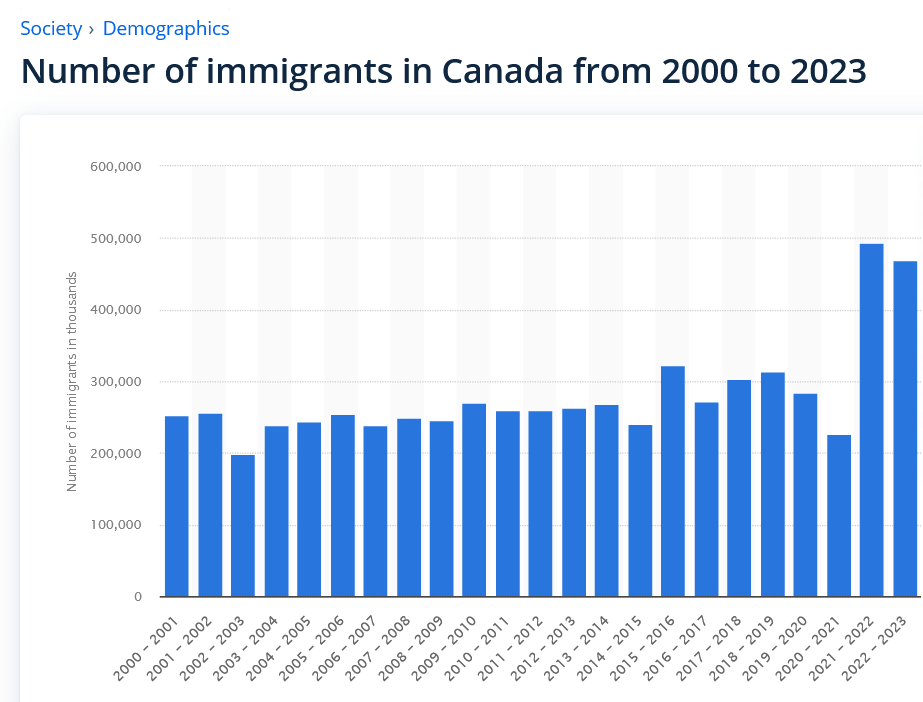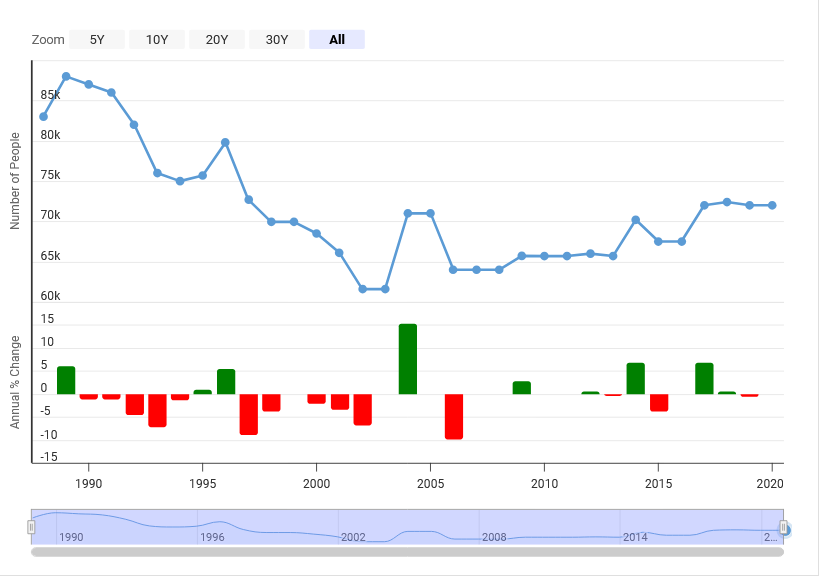Here’s a lesson in statistics and manipulative media.
Policy Options’s Eugene Lang takes a look at public service employment statistics and manages to get just about everything wrong by misrepresenting what the data actually says.
His very first words are a fabrication: “Forty-three per cent. That is how much Canada’s ‘core’ federal public administration — the civil service — has grown since Justin Trudeau’s government took office in 2015.”
I mean, it’s not like they are a lie, exactly. But the actual statistics – cited in Lang’s own article – tell a very different story.
First, they go back 14 years, so we can see the change between the last years of Stephen Harper’s unpopular government, which lost 60 seats and the majority in the 2015 election. This shows a change from 282,980 to 367,772 employees, only a 30 percent increase over a longer time period.
Also, in 2010 Canada was 34 million people; in 2024 it’s 40.8 million, an increase of 6.8 million, a 20 percent increase. That’s more than the 17 percent cited by Lang, and leaves us with only a ten percent increase in the size of the public service to explain, a far smaller issue than Lang represents it to be.
But sure. It’s still an issue.
Lang identifies what he calls “the big six” public services department that he represents as constituting most of the increase: revenue, employment, immigration, fisheries, procurement, and defence.
Revenue Canada (now Canada Revenue Agency) increased from 43K in 2010 to 59K in 2024. Harper had slashed it by 3000 employees in the interim. Ignoring the Harper cuts, this is still a 37 percent increase, almost double the size of the population increase but explainable in part by the increase in Canada’s GDP, from 1.6 trillion to 2.14 trillion, over the same time period.
Employment and Social Development increased from 26K to 39K since 2010. Again, it suffered a lot in the Harper cuts, losing six thousand people in just a couple of years. Still, from 2010 it’s still a 30 percent increase, on par with the increase in the size of the public service as a whole.
Immigration jumped from 4.7K in 2010 to 13K in 2024, almost tripling in size. It was not cut by Harper. Immigration over that time was a relatively stable 300K per year, dipping during the pandemic, and only jumping to 500K in the last two years, by which time the department had already expanded to 10K. So the immigration surge does not explain the expansion, contrary to Lang’s explanation. What does? Well, it could be Passport Canada, which went from almost 3K in 2020 to 0 in 2024.

Fisheries and Oceans expanded from 11.1K to 14.7 K, an increase of 32 percent, on par with the government as a whole. It was again singled out by the Harper administration for a 20 percent cut.
Public Services and Procurement went from 13.7K to 19K, a 38 percent increase, a bit above average. Lang suggests the increase “may have been caused by the urgent need during the pandemic to acquire mass quantities of everything from masks to vaccines.” This does account for about 3K new hires, and if we subtract these the increase in the department is less than in the public service as a whole.
National Defense went from 27.2K in 2010 to 28.7K in 2024. Hidden in this small increase is another huge cut by the Harper government of almost 5 thousand staff. This is civilian staff only; Canada’s active military includes “approximately 68,000 active personnel and 27,000 reserve personnel” and despite Lang’s claims that they “have been hemorrhaging military personnel” have been relatively stable over the last 15 years (pictured).

So – to summarize – only one of the departments cited increased much beyond the average for the public service as a whole. What characterizes them, in reality, is that they were singled out by the Harper administration for huge cuts, and these were reversed by the Trudeau government gradually over the last ten years. Which raises the question: why shouldn’t Trudeau have reversed the cuts made by a deeply unpopular government he had just swept away with a majority?
Curiously, Lang reserves a lot of his criticism for the Privy Council Office, which went from 905 in 2010 to 1288 today. He suggests it offers “more evidence of the pernicious trend toward prime ministerial government”, which seems wrong considering that Harper cut staff by about 300 and was even more centralized on the Prime Minister than the Trudeau government.
That’s what Lang had to say. Let’s look at what he left out.
First are the many departments that decreased in size over the same period: Agriculture, Canada School of Public Service, Industrial Relations Board, Canadian Heritage, Health Canada, the aforementioned Passports Canada, Public Service Commission, Crown-Indigenous Relations and Northern Affairs Canada (with a 3.3K drop), Statistical Survey Operations (from 1800 in 2010 to 9 in 2024) and Veterans Affairs. The changes in these numbers suggest a lot of realignment of responsibilities between departments over that time.
Even more significant are the increases that did not for some reason attract Lang’s attention. Let’s look at some of these.
The Border Services agency went from 14.3K to 17.2K, an increase of 3000 people. What distinguishes it is that it was not a target for the Harper cuts. Lang seems to have no issue with an increase of 3000 people, though, odd considering his obsession over 300 in the Privy Council Office. Border Services appears to be due for an even larger increase in the coming year.
The Public Health Agency of Canada increased by 1,400 people, especially over the last three years, and it is probably here where we’re seeing the impact of the new pharmacy and dental programs.
The RCMP civilian staff jumped from 6.2K to 10.3K, a raw increase of 4.1K, amounting to a 66 percent increase. This is more than several of the ‘big six’ but merits no mention from Lang. There are also 18,988 regular RCMP officers.
One of the biggest jumps of all, and completely ignored by Lang, was Shared Services Canada (SSC), a massive boondoggle foisted on us by the Harper government, that went from 0 in 2010 to 9,500 employees in 2024. SSC is the agency responsible for the Phoenix Pay System debacle and has overseen numerous cyber-intrusions over the last decade.
I think the plan was to spin off SCC into a private agency, where it would continue to soak the Canadian taxpayer for billions of dollars, but represent a substantial cut in the dreaded ‘public service employment’ numbers. Watch for a Poilievre government to revive this plan.
The Communications Security Establishment Canada (CSEC) doubled in size from 1.7K to 3.4K and is yet unmentioned by Lang. The Canadian Security Intelligence Service (CSIS) has an additional 3,200 employees, but wasn’t listed at all in the full statistics. Odd, that.
The Office of the Superintendent of Financial Institutions Canada tripled in size, up to 1,323 staff. Not a huge increase in total numbers, but still greater than the Privy Council Office, and reflective of an even more worrisome trend. The increase probably reflects the emergence of blockchain.
I said at the outset we have here a lesson in statistics and manipulative media. Let’s make that clear now.
Lang’s focus was on the departments that were cut by Harper in the years leading to the 2015 election and restored by Trudeau in the years that followed. Other than this trend, in increase in the size of the public service is almost entirely explained by the increase in population and economic activity over the last 14 years.
He doesn’t actually mention the Harper cuts; he just assumes them as a baseline. But it is an entirely artificial and arbitrary baseline, all the more so because it represents an aberration in Canadian government spending, and not the norm. Using this as a baseline misrepresents both the size and the recency of the increase in the Canadian public service.
And his choice of focus obscures some very sizable increases in other areas of the public service, increases that had two major causes: Harper government mismanagement and (attempted) privatization of government computer services, and increases in border and security infrastructure. This is a very different picture from the one of public service bloat Lang is trying to portray.